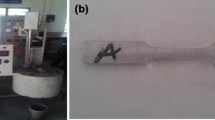Abstract
Iron and aluminum form a number of intermetallic phases, which have a quite high hardness and can be used for manufacturing parts of equipment operating under abrasive wear conditions. In addition, the advantage of applying iron–aluminum intermetallic alloys is a low cost and the lack of deficiency of the alloy components (aluminum, iron). However, all intermetallic compounds of this system have a high brittleness, and this fact restricts the region of applying the alloys based on iron–aluminum intermetallic phases. As an alternative to the parts made of the intermetallic alloys, steel–iron aluminide composites are proposed. The technology of manufacturing these composites is described. The studies performed in this work show that the proposed technology enables the formation of composite materials of adequate quality. The ultimate compressive strength of porous steel is ~145 MPa, and that of the composite material is higher than 435 MPa. The hardness of the intermetallic portions of the composite material is 385–400 HB, and the relative wear resistance of the composite material is ~6.





Similar content being viewed by others
REFERENCES
V. P. Ryabov, Aluminizing of Steel (Metallurgiya, Moscow, 1973).
A. I. Kovtunov and T. V. Chermashentseva, “Service properties of surfacing iron–aluminum-based alloys,” Voprosy Materialoved., No. 3, 91–96 (2012).
R. A. Lidin, V. A. Molochko, and L. L. Andreeva, Chemical Properties of Inorganic Materials, Ed. by R. A. Lidin (KolosS, Moscow 2006).
R. A. Lidin, L. L. Andreev, and V. A. Molochko, Constants of Inorganic Materials: A Handbook, Ed. by R. A. Lidin (Drofa, Moscow, 2006).
O. V. Shashkin, “Vacuum conveyer brazing of titanium and titanium–aluminum constructions by aluminum-based solders,” Cand. Sci. (Eng.) Dissertation, Togliatti, TSU, 2006.
N. P. Lyakishev, Phase Diagrams of Binary Metallic Systems (Mashinostroenie, Moscow, 1996).
V. Raghavan, “Al–C–Fe (Aluminum–Carbon–Iron),” J. Phase Equil. Diff. 23 (6), 508–510 (2002).
V. Raghavan, “Al–C–Fe (Aluminum–Carbon–Iron),” J. Phase Equil. Diff. 27 (3), 284–287 (2006).
V. Raghavan, “Al–C–Fe (Aluminum–Carbon–Iron),” J. Phase Equil. Diff. 14 (5), 615–617 (1993).
Funding
This work was supported by the Ministry of Education and Science of the Russian Federation, state assignment no. 11.6065.2017/8.9.
Author information
Authors and Affiliations
Corresponding author
Additional information
Translated by Yu. Ryzhkov
Rights and permissions
About this article
Cite this article
Kovtunov, A.I., Khokhlov, Y.Y. & Myamin, S.V. Formation and Properties of Steel–Iron Aluminide Composites. Russ. Metall. 2020, 1522–1525 (2020). https://doi.org/10.1134/S0036029520130170
Received:
Revised:
Accepted:
Published:
Issue Date:
DOI: https://doi.org/10.1134/S0036029520130170




